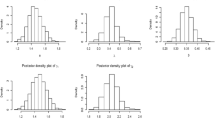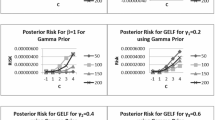Abstract
This study deals with the reliability analysis of a multi-component load sharing system where failure of any component within the system induces higher failure rate on the remaining surviving components. It is assumed that each component failure time follows Chen distribution. In classical set up, the maximum likelihood estimates of the load sharing parameters, system reliability and hazard rate along with their standard errors are computed. Since maximum likelihood estimates are not in closed form, so asymptotic confidence intervals and two bootstrap confidence intervals for the unknown parameters have also been constructed. Further, by assuming both informative and non-informative prior for the unknown parameters, Bayes estimates along with their posterior standard errors and HPD intervals of the parameters are obtained. Thereafter, a simulation study elicitates the theoretical developments. A real data analysis, at the end, eshtablishes the applicability of the proposed theory.








Similar content being viewed by others
References
Kapur KC, Lemborson LR (1977) Reliability in engineering design. Wiley, Chichester
Lewis EE (1987) Introduction to reliability engineering. Willey, Chichester
Crowder MJ, Kimber AC, Smith LL, Sweeting TJ (1991) Statistical analysis of reliability data. Chapman and Hall, New York
Jain M, Gupta R (2012) Load sharing M-out of-N: G system with non-identical components subject to common cause failure. Int J Math Oper Res 4(5):586–605
Liu H (1998) Reliability of a load-sharing k-out-of-n: G system: non-iid components with arbitrary distributions. IEEE Trans Reliab 47(3):279–284
Levitin G, Dai YS (2007) Service reliability and performance in grid system with star topology. Reliab Eng Syst Saf 92(1):40–46
Yu H, Eberhard P, Zhao Y, Wang H (2013) Sharing behavior of load transmission on gear pair systems actuated by parallel arrangements of multiple pinions. Mech Mach Theory 65:58–70
Basu AK, Bhattacharya A, Chowdhury S, Chowdhury SP (2012) Planned scheduling for economic power sharing in a CHP-based micro-grid. IEEE Trans Power Syst 27(1):30–38
Gurov SV, Utkin LV (2012) Load-share reliability models with the piecewise constant load. Int J Reliab Saf 6(4):338–353
Kvam PH, Pena EA (2005) Estimating load-share properties in a dynamic reliability system. J Am Stat Assoc 100:262–272
Singh B, Rathi S, Kumar S (2013) Inferential statistics on the dynamic system model with time-dependent failure-rate. J Stat Comput Simul 83(1):1–24
Durham SD et al (1997) Localized load-sharing rules and Markov–Weibull fibers: a comparison of micro composite failure data with Monte Carlo simulations. J Compos Mater 31:856–1882
Singh B, Sharma KK, Kumar A (2008) Classical and Bayesian estimation of a k components load share parallel system. Comput Stat Data Anal 52:5175–5185
Daniels HE (1945) The statistical theory of the strength bundles of threads. Proc R Soc Ser B 34:187–220
Coleman BD (1957) Time dependence of mechanical breakdown in bundles of fibers I. Constant total load. J Appl Phys 28:1058–1064
Rosen BW (1964) Tensile failure of fibrous composites. AIAA J 2:1985–1991
Harlow DG, Phoenix SL (1978) Probability distribution for the strength of fibrous materials under local load sharing: two level failure and edge effects. Adv Appl Prob 14:68–94
Ross SM (1984) A model in which component failure rates depend on the working set. Naval Res Logist Q 31:297–300
Durham SD, Lynch JD (2000) A threshold representation for the strength distribution of a complex load sharing system. J Stat Plan Inference 83:25–46
Kim K, Kvam PH (2004) Reliability estimation based on system data with an unknown load share rule. Lifetime Data Anal 10:83–94
Singh B, Sharma KK, Kumar A (2009) Analyzing the dynamic system model with discrete failure time distribution. Stat Methods Appl 18:521–542
Singh B, Gupta PK (2012) Load-sharing system model and its application to real data set. Math Comput Simul 82(9):1615–1629
Singh B, Gupta PK (2014) Bayesian reliability estimation of a 1-out-of-k load-sharing system model. Int J Syst Assur Eng Manag 5(4):562–576
Park C (2010) Parameter estimation for reliability of load sharing systems. IIE Trans 42:753–765
Park C (2013) Parameter estimation from load-sharing system data using the expectation maximization algorithm. IIE Trans 45(2):147–163
Rajarshi S, Rajarshi MB (1988) Bathtub distributions: a review. Commun Stat Theory Methods 17(8):2597–2621
Wu SJ (2008) Estimation of the two-parameter bathtub-shaped lifetime distribution with progressive censoring. J Appl Stat 35:1139–1150
Dey S, Sharma VK, Mesfioui M (2017) A new extension of Weibull distribution with application to lifetime data. Ann Data Sci. doi:10.1007/s40745-016-0094-8
Chen Z (2000) A new two-parameter lifetime distribution with bathtub shape or increasing failure rate function. Stat Probab Lett 49(2):155–161
Wu JW, Lu HL, Chen CH, Wu CH (2004) Statistical inference about the shape parameter of the new two-parameter bathtub-shaped lifetime distribution. Qual Reliab Eng Int 20:607–616
Sarhan AM, Hamilton DC, Smith B (2012) Parameter Estimations for a two parameter bathtub-shaped lifetime distribution. Appl Math Model 36(11):5380–5392
Ahmed EA (2014) Bayesian estimation based on progressive type-II censoring from two-parameter bathtub-shaped lifetime model: an Markov chain Monte Carlo approach. J Appl Stat 41(4):752–768
Rastogi MK, Tripathi YM (2013) Estimation using hybrid censored data from a two parameter distribution with bathtub shape. Comput Stat Data Anal 67:268–281
Kayal T, Tripathi YM, Singh DP, Rastogi MK (2016) Estimation and prediction for Chen distribution with bathtub shape under progressive censoring. J Stat Comput Simul. doi:10.1080/00949655.2016.1209199
Efron B (1982) The Jackknife, the Bootstrap and other re-sampling plans. In: CBMS-NSF regional conference series in applied mathematics society. SIAM, p 38
Hall P (1988) Theoretical comparison of bootstrap confidence intervals. Ann Stat 16:327–353
Chen MH, Shao QM (1999) Monte Carlo estimation of Bayesian credible and HPD intervals. J Comput Graph Stat 8:69–92
Dey S, Kumar D, Ramos PL, Louzada F (2017) Exponentiated Chen distribution: properties and estimation. Commun Stat Simul Comput. doi:10.1080/03610918.2016.1267752
Acknowledgements
The authors gratefully acknowledge the critical suggestions and comments from the learned referee which greatly helped us in the improvement of this paper.
Author information
Authors and Affiliations
Corresponding author
Rights and permissions
About this article
Cite this article
Pundir, P.S., Gupta, P.K. Reliability Estimation in Load-Sharing System Model with Application to Real Data. Ann. Data. Sci. 5, 69–91 (2018). https://doi.org/10.1007/s40745-017-0120-5
Received:
Revised:
Accepted:
Published:
Issue Date:
DOI: https://doi.org/10.1007/s40745-017-0120-5




